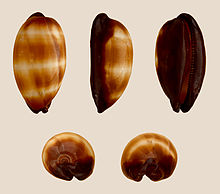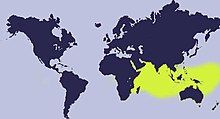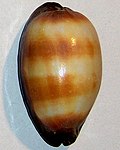Talparia talpa
| Talparia talpa | |
|---|---|

| |
| A live Talparia talpa in situ with its mantle almost fully extended, anterior end towards the right | |

| |
| Five views of a shell of Talaria talpa | |
| Scientific classification | |
| Domain: | Eukaryota |
| Kingdom: | Animalia |
| Phylum: | Mollusca |
| Class: | Gastropoda |
| Subclass: | Caenogastropoda |
| Order: | Littorinimorpha |
| Family: | Cypraeidae |
| Genus: | Talparia |
| Species: | T. talpa
|
| Binomial name | |
| Talparia talpa | |

| |
| Distribution map of Talparia talpa | |
| Synonyms[1] | |
Talparia talpa, common name the mole cowry or chocolate banded cowry, is a species of sea snail, a cowry, a marine gastropod mollusk in the family Cypraeidae, the cowries.[1]
Subspecies
[edit]- Talparia talpa lutani Bridges, 2015
- Talparia talpa talpa (Linnaeus, 1758)
- Synonyms
- Talparia talpa imperialis Schilder, F.A. & M. Schilder, 1938:[2] synonym of Talparia talpa (Linnaeus, 1758)
- Talparia talpa var. lewallorum Lorenz, 2015: synonym of Talparia talpa (Linnaeus, 1758) (unavailable name: infrasubspecific rank)
- Talparia talpa saturata (Dautzenberg, Ph., 1903):[3] synonym of Talparia talpa (Linnaeus, 1758)
Description
[edit]The shells of these quite uncommon cowries reach on average 50–70 millimetres (2.0–2.8 in) of length, with a minimum size of 23 millimetres (0.91 in) and a maximum size of 105 millimetres (4.1 in). They are very variable in pattern and colour. The dorsum surface is smooth and shiny, the basic color is brown or yellowish brown, with three or four yellow or light brown transversal bands. The margins, the base and the teeth are completely dark brown or black. Also the teeth are dark brown, but the teeth spacing is clearer or white. In the living cowries the mantle is greyish or black, with long cylindrical papillae. Mantle and foot are well developed, with external antennae. The lateral flaps of the mantle may hide completely the shell surface and may be quickly retracted into the shell.
 |
 |

Distribution
[edit]This species occurs in the Red Sea and in the Indian Ocean along East Africa (Aldabra, Chagos, the Comores, Eritrea, Kenya, Madagascar, the Mascarene Basin, Mauritius, Mozambique, Réunion, the Seychelles, Somalia and Tanzania), in the western Pacific (western Australia, Philippines), in Polynesia and Hawaii.
Fossils of this species have been found in Pliocene or Pleistocene strata on Guam.
Habitat
[edit]These cowries live on coral reef or in shallow lagoons in tropical intertidal and subtidal waters up to 30 m depth. They can be found under ledges and in small coral caves at night, as they start feeding at dusk.
References
[edit]- ^ a b Talparia talpa (Linnaeus). WoRMS (2009). Talparia talpa (Linnaeus). Accessed through the World Register of Marine Species at http://www.marinespecies.org/aphia.php?p=taxdetails&id=216894 on 23 October 2010 .
- ^ Gastropods.com : Talparia talpa imperialis; accessed : 23 october 2010
- ^ "Talparia talpa saturata". Gastropods.com. Retrieved 23 October 2010.
- Verdcourt, B. (1954). The cowries of the East African Coast (Kenya, Tanganyika, Zanzibar and Pemba). Journal of the East Africa Natural History Society 22(4) 96: 129-144, 17 pls.
- Burgess, C.M. (1970). The Living Cowries. AS Barnes and Co, Ltd. Cranbury, New Jersey
- Lorenz F. (2015). A dwarf variation of Talparia talpa. Beautifulcowries Magazine. 7: 31-32
- Liu, J.Y. [Ruiyu] (ed.). (2008). Checklist of marine biota of China seas. China Science Press. 1267 pp.
- Steyn, D. G.; Lussi, M. (2005). Offshore Shells of Southern Africa: A pictorial guide to more than 750 Gastropods. Published by the authors. pp. i–vi, 1–289.
External links
[edit]- Biolib
- Gastropods.com : Talpa talpa : photos; accessed : 23 October 2010
- Talparia talpa
- Linnaeus, C. (1758). Systema Naturae per regna tria naturae, secundum classes, ordines, genera, species, cum characteribus, differentiis, synonymis, locis. Editio decima, reformata
- Ladd, H.S. (1977). Cenozoic fossil mollusks from western Pacific islands; Gastropods (Eratoidae through Harpidae). U.S. Geological Survey Professional Paper. 533: i–iv, 1–84, pls 1–23
 This article incorporates text from this source, which is in the public domain.
This article incorporates text from this source, which is in the public domain.
